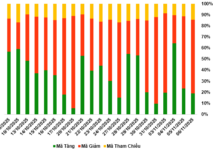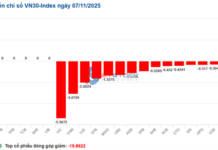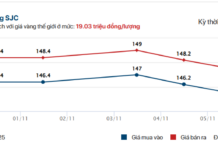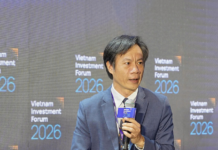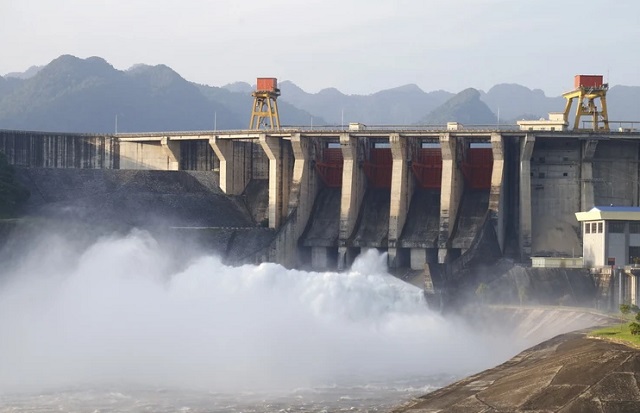
Tuyen Quang Hydropower Plant. (Photo: Nam Suong/VNA)
|
Hydropower is considered the backbone of Vietnam’s electricity source structure, providing not only a large amount of electricity for socio-economic development but also promoting comprehensive efficiency such as water supply, flood prevention, flood reduction, facilitating waterway traffic, and aquaculture…
However, with the Government’s incentive policies, many renewable energy projects have been put into construction and operation.
Despite supplementing a large amount of electricity for socio-economic development, this power source also creates considerable challenges in operating the power system.
Many experts believe that the potential for hydropower exploitation remains very large in the context of increasing electricity demand.
Can continue to expand
According to the Eighth Power Plan, orienting towards 2030, the total capacity of hydropower sources, including small hydropower, is expected to reach 29,346MW, producing 101.7 billion kWh; By 2050, the total capacity of hydropower sources is expected to reach over 36,000MW, producing more than 114 billion kWh per year.
As of the end of 2023, the total capacity of hydropower sources reached nearly 23,000MW and the electricity output reached over 80 billion kWh.
According to energy experts, with abundant hydropower sources, Vietnam can continue to exploit a maximum of 30,000-38,000MW and the electricity that can be exploited can reach 120 billion kWh per year. This is a perfect, reliable source due to its flexible power generation capability.
According to Dr. Nguyen Huy Hoach, an energy expert, with low operating costs, hydropower plants are the most flexible and reasonable source in Vietnam’s power system today.
In particular, with future storage technologies such as pumped-storage hydroelectricity and battery storage, they will complement and support each other in the power system.
 Song Ba Ha Hydropower Plant (Phu Yen) discharges water downstream. (Photo: Pham Cuong/VNA)
|
According to the Eighth Electricity Plan, the 2021-2023 period will continue to build 13 hydropower projects that have been planned and continue to study and develop riverbed hydropower plants.
For rivers with a low gradient, it is possible to develop a type of riverbed hydropower plant with a low water column. However, at present, low-water-column hydropower plants have not been widely built yet, which can be considered as potential for further exploitation in the future.
Ha Dang Son, Director of the Center for Energy and Green Development, said that investing in expanding a number of operating hydropower plants will allow for additional peak power supply to the power system, reaching a reasonable level of water resource use by the river.
On the other hand, when hydropower plants are expanded, they will supply an additional significant amount of energy and improve the quality of electricity for the system. At the same time, it reduces the workload of existing units, thereby extending the life of the equipment, saving maintenance and repair costs.
According to experts on environmental impacts, hydropower expansion projects do not increase adverse impacts on the environment because they do not change the status of the dam structure and the reservoir.
Currently, EVN has expanded the Thac Mo Hydropower Plant by 75MW (put into operation in 2017) and the Da Nhim Hydropower Plant expanded by 80MW (put into operation in 2018).
As for the Ialy Hydropower project expanding by an additional 360MW currently under construction, striving to be put into operation this year and the Hoa Binh Hydropower project expanding by an additional 480MW is striving hard at the highest level to put the plant into operation in 2025.
According to Dr. Nguyen Huy Hoach, with 41 large hydropower plants with a capacity of 100 MW or more with a total installed capacity of 14,330MW capable of expansion, the remaining potential is enormous.
Downstream hydropower and pumped storage
Investing in expanding a number of hydropower plants will allow for additional peak power supply to the power system, reaching a reasonable level of using Vietnam’s existing renewable energy resources.
Currently, in the world, many countries are taking advantage of the available water resources from reservoirs to arrange downstream hydropower plants to fully exploit this artificial hydropower source.
 Song Hinh Hydropower Reservoir (Phu Yen). (Photo: Ngoc Ha/VNA)
|
The country has more than 7,000 dams, irrigation reservoirs are in operation, with a total storage capacity of about 14.5 billion m3, creating a source of water for agriculture, domestic use, industry, etc. This is also a great advantage if Vietnam can take advantage of exploitation, building hydropower plants behind dams from currently operating irrigation reservoirs.
Dr. Nguyen Huy Hoach said that it is necessary to survey all irrigation reservoirs, identify which irrigation reservoirs can build hydropower plants behind the dam embankment to increase additional flexible power sources for the system.
Regarding pumped-storage hydropower, Mr. Nguyen Huy Hoach also added that these projects do not increase electricity output but the main task is to reduce the difference in load curves by mobilizing pumping capacity to accumulate water during off-peak hours and generate electricity during peak hours. This is also a type commonly used in the world.
According to the assessment of this expert, Vietnam’s potential for exploiting pumped-storage hydropower has 9 locations that can be built and exploited with a total capacity of 12,500MW.
The Bac Ai Pumped-Storage Hydropower Plant with a capacity of 1,200MW is the first plant that was started construction in early 2020 and is expected to be completed in 2028.
According to the Eighth Electricity Plan, by 2030, there will be 2,700MW of capacity from pumped-storage hydropower, with a battery storage system, the capacity will increase to 39,700MW by 2050…
With the increasing proportion of renewable energy being put into operation to achieve the goal of reducing emissions, maximizing and effectively exploiting various forms of hydropower is a solution that many experts assess can help reserve generation capacity, stabilize the system, and adjust frequency. This is also a tool to help the national power system operate stably, safely, and reliably./.
Duc Dung




